Abstract
Background:
The methicillin-resistant Staphylococcus aureus (MRSA) strain is now the most commonly reported antibiotic-resistant bacterium in clinical settings. Therefore, there is an urgent need to develop novel antibacterial agents to control this pathogen. Bacteriophages are a potential alternative treatment for MRSA infections.Objectives:
The objective of this study was the isolation and characterization of MRSA phages from the sewage at a tertiary pediatric hospital.Methods:
Two MRSA strains were isolated from patient blood. The isolated strains were confirmed as MRSA through the conventional methods. Phages were then isolated from the sewage at the tertiary pediatric hospital. Lytic activity was determined with a spot test, while the titers of phage lysates were measured using the DLA technique. The morphology was assessed using electron microscopy, and the latent period time and burst size were determined.Results:
Electron microscopy showed MRSA phages’ resemblance to members of the family Siphoviridae, serogroups A and F. They exhibited a latent period of 70 minutes and a relatively burst size of 2,400 plaque-forming units (PFU)/infected cell. The titer of the phages was determined to be 3 × 109 PFU/mL using the by DLA technique.Conclusions:
In this study, two phages from the family Siphoviridae were isolated and characterized from sewage at a tertiary pediatric hospital; these phages specifically target MRSA. Their presence may be one reason for the transfer of antibiotic resistance or virulence factors, resulting in transduction and the conversion of nonvirulent strains of Staphylococcus to virulent strains. Considering that phages through can be transferred to wards in an air-born manner, it is better to create negative pressure in the sewage pipes at hospitals until the phages can no longer transfer to the wards via aerosols.Keywords
Bacteriophage Methicillin-Resistant Staphylococcus aureus (MRSA) Hospital Sewage Siphoviridae
1. Background
Hospital-acquired methicillin-resistant Staphylococcus aureus (HA-MRSA) was first isolated in hospitals in the United Kingdom in 1961 (1, 2). MRSA has since become widespread in hospitals (3, 4), and it now accounts for > 60% of S. aureus isolates from hospitals; moreover, it is one of the most prevalent agents causing nosocomial diseases in pediatric hospitals (5, 6). MRSA is increasingly resistant to typically used antibiotics, such as methicillin, dicloxacillin, oxacillin, nafcillin and vancomycin (7-10). Due to more widespread treatment with antibiotics and the increasing prevalence of antibiotic-resistant bacteria, use of bacteriophages and their endolysins could be an effective alternative in the treatment of infections. Bacteriophages (or phages) are natural bacterial viruses that attach specifically to their hosts and lyse them.
The first human phage therapy was reported in relation to the treatment of S. aureus skin infections. Phages have been reported to be effective in treating various bacterial diseases, such as skin infections caused by Staphylococcus, staphylococcal lung infections, neonatal sepsis, urinary tract infections, and diabetic foot as a complication of diabetes; bacteriophages have also been suggested as effective antibiofilm agents.
Treatment of MRSA using phages can be accomplished via local application for local infections, intraperitoneal administration for systemic infections, and the use of oral phage therapy to target MRSA in nurses who are carriers. Endolysins (or lysins) are produced by bacteriophages; they have been successfully used to control pathogenic antibiotic-resistant bacteria found on mucosal surfaces and in infected tissues with a low chance of bacterial resistance (11, 12).
Phages specifically recognize their hosts, and any region has specific phages; previous publications have demonstrated that any region has specific phages against MRSA and phages have specific hosts (13-15). Phages of S. aureus belong to the order Caudovirales and consist of double-stranded DNA located in the icosahedral capsid. According to the tail morphology, they can be classified into three families, namely Podoviridae, Siphoviridae, and Myoviridae (16). Isolations from wastewater have been carried out for phages against many bacteria, such as Escherichia coli, Pseudomonas aeruginosa, Acinetobacter sp., Klebsiella sp., Enterococcus faecalis, and Stenotrophomonas maltophilia, but phages against MRSA have not been isolated from wastewater at tertiary pediatric hospital (17-22).
Sewage is known to be rich sources of bacteriophages (23). Hospital sewage represents an extremely selective environment where high rates of resistant bacteria are evacuated in the natural environment or through animal fecal wastes; both hospital sewage and fecal wastes, can be environmental vectors for the horizontal transfer of antibiotic-resistant genes via transduction by bacteriophages (24, 25). Therefore, agents of antibiotic resistance are not only found in pathogenic bacteria but also in environmental organisms. More resistant bacteria are found in polluted habitats compared with unpolluted ones, indicating that environmental factors, such as sewage, have significantly contributed to the increased proportion of resistant bacteria occurring in the environment (26). The presence of phages in sewage is one element that can be used to justify the transfer of antibiotic resistance or virulence factors through transduction (27). Studies have demonstrated that prophages are integrated into the bacterial chromosomes and represent the most mobile genetic elements in S. aureus strains (28).
2. Objectives
Our objectives in this study were to characterize the structure and morphology of methicillin-resistant Staphylococcus aureus (MRSA) phages from a tertiary pediatric hospital.
3. Methods
3.1. Bacteriophage Isolation and Purification
Liquid samples of sewage at a volume of 200 cc were collected from the septic tank at the tertiary pediatric Bouali Sina hospital in Sari, Mazandaran province, northern Iran. The samples were transported to the laboratory and stored at 4°C. Ten milliliters of samples were centrifuged (11,100 × g, 5 minutes). Following this, the supernatant mixed with chloroform, centrifuged (11,100 × g, 5 minutes), and then filtered through a 0.22-μm filter. An equal volume of 2 X LB broths (QUELAB, United States) was added to the sample and cultured overnight with MRSA strains (29, 30) that were previously isolated from the blood of infant with septicemia at Buali Sina hospital.
3.2. Preparation of Bacterial Strains
Two isolated strains of MRSA were confirmed using conventional methods. The isolates were streaked for purity growth on a blood agar plate and incubated at 37˚C overnight. Microscopic examination of Gram stain smears from a Staphylococcus culture, as well as tube coagulase, catalase, DNase, and mannitol fermentation tests were performed on the specimens. For the detection of MRSA, the Kirby–Bauer disk diffusion technique was carried out using by methicillin and oxacillin antibiotic discs. MIC was carried out with E-test packages for vancomycin and linezolid (HiMedia, India) (31-33). The specimens were then incubated at 37°C and shaken overnight. The cultures were centrifuged at 4°C (10,000 × g; 10 minutes), and the supernatant was filtered using 0.22-μm (pore size) Millipore filters. To detect the presence of phages, the spot test was performed. The filtered phage lysate was titrated using the DLA technique (29, 30).
3.3. Determination of the Host Range
3.3.1. The Spot Test
An overnight culture of the potential indicator MRSA (100 μL) was mixed in a sterile tube with 3 mL of 0.4% soft agar; the contents were poured into petri dishes containing 15 mL of 1% bottom agar. The plate was placed on a bench until the soft agar had solidified, and then 5 μL of the sterile supernatant was poured over the solidified soft agar. After it had absorbed, the petri dishes were incubated upside up at 37°C overnight. The following day, the petri dishes were checked for zones of clearing (29, 30).
3.4. Double-Layer Plaque Assay (DLA Assay)
Phage stock and susceptible bacteria cell cultures were provided. Tenfold dilutions of the phage stock were added to 100 µl of bacterial suspensions. This solution was added to 3 mL of top agar and mixed gently, then poured into a petri dish containing 25 mL of bottom agar. The plates were incubated at 37°C overnight. The next day, the number of plaques was counted. Plaque-forming units (PFU) were calculated per milliliter by determining the number of plaques × 10 × the inverse of the dilution factor (29, 30).
3.5. Electron Microscope Observation of Phages
Bacteriophages were concentrated by centrifugation at 25,000 × g for 60 minutes using a high-speed centrifuge followed by two washes in 0.1 M neutral ammonium acetate. Purified bacteriophages were deposited on carbon-coated copper grids and stained with 2% uranyl acetate (pH = 4 - 4.5). After staining, phages were observed on a Philips CM 300 electron microscope at 150 kV (29, 30).
3.6. The Single-Step Growth Curve
Phage lysates were added to 100 μL of LB broth containing MRSA and preincubated for 10 minutes at 37°C for the adsorption of phages. After 10 minutes, this mixture was diluted in the LB broth medium (QUELAB, United States) and 100 µL of bacterial suspensions were added. Tubes were incubated from 10 minutes to 5 hours at 37°C. Samples were periodically removed from the mixture, and the number of free phages were counted using a plaque assay. The next day, the number of plaques was counted. PFU were calculated per milliliter as the number of plaques × 10 × the inverse of the dilution factor (29, 30).
4. Results
The results confirmed the isolation of MRSA from the blood of infants with septicemia.
4-1. Microscopic examination Gram stain smears showed a Gram-positive cluster of cocci.
4-2. Tests for catalase and coagulase were positive, exhibiting the formation of oxygen bubbles and clots, respectively (Table 1).
Specifications of MRSA Isolated From the Blood of Infants with Septicemia
| Test | Result | |
|---|---|---|
| Gram staining | Gram-positive cocci | |
| Catalase test | Positive | |
| Coagulase test | Positive | |
| DNase test | Positive | |
| Mannitol fermentation test | Positive | |
| Oxacillin, 2 μg/mL | Methicillin, 5 μg/mL | |
| The Kirby–Bauer technique using the disk diffusion method | Resistant | Resistant |
| Determination of MIC with an Etest | Vancomycin | Linezolid |
| > 0.128 μg/mL | > 0.01 μg/mL |
4-3. The DNase test was found to be positive due to the formation of a transparent halo after HCL was added (Table 1).
4-4. The mannitol fermentation test was reported to be positive because the color of the culture was modified (Table 1).
4-5. The Kirby-Bauer technique using the disk diffusion method with oxacillin (2 µg/mL) and methicillin (5 μg/mL) discs showed that the samples were quite resistant (Table 1; Figure 1).
S. aureus (MRSA) Resistant to 2 μg/mL Oxacillin
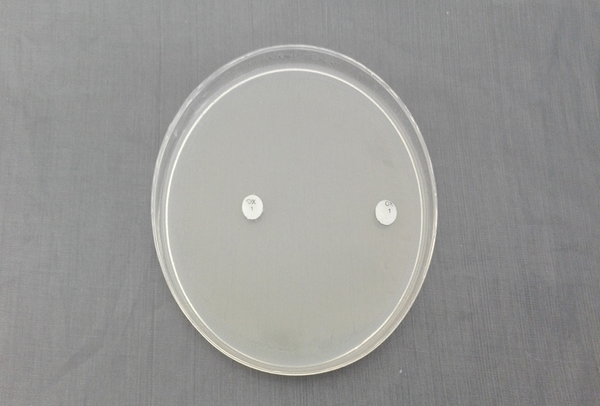
4-6. The MIC was carried out with Etest packages for vancomycin and linezolid, and the results were > 0.128 μg/mL and > 0.01 μg/mL, respectively (Table 1; Figure 2).
S. aureus (MRSA) MICs Determined by E-test, Antibiotics (A) Linezolid, > 0.01 μg/mL and (B) Vancomycin, > 0.128 μg/mL
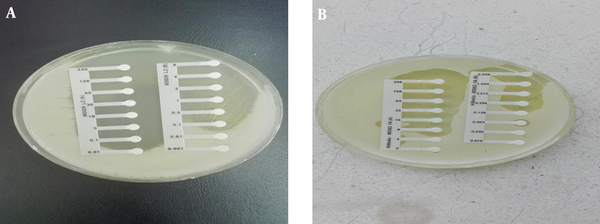
4-7. In the spot test, clear plaques observed on LB agar plates were covered with a bacterial lawn of MRSA; this demonstrated that the phages were isolated and had lytic activity (Figure 3).
A Spot Test Checking the Presence of Bacteriophage
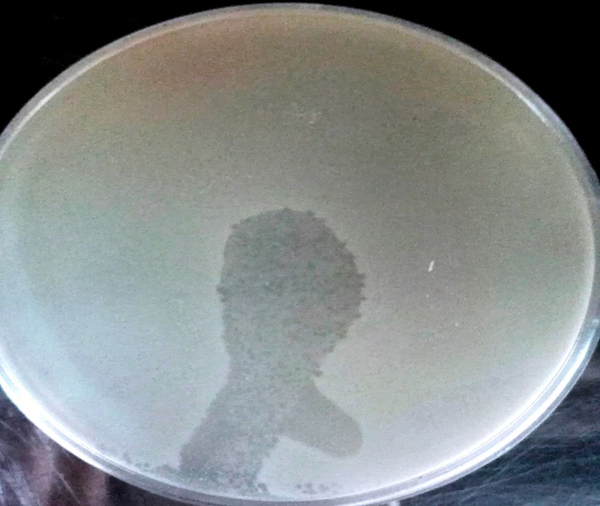
4-8. In the DLA technique, plaques of 9 - 14 μm in diameter formed, and the titer-isolated and purified phages were 3 × 109 PFU/mL-1 (Figure 4).
A DLA Technique Showing the Bacteriophage Titer
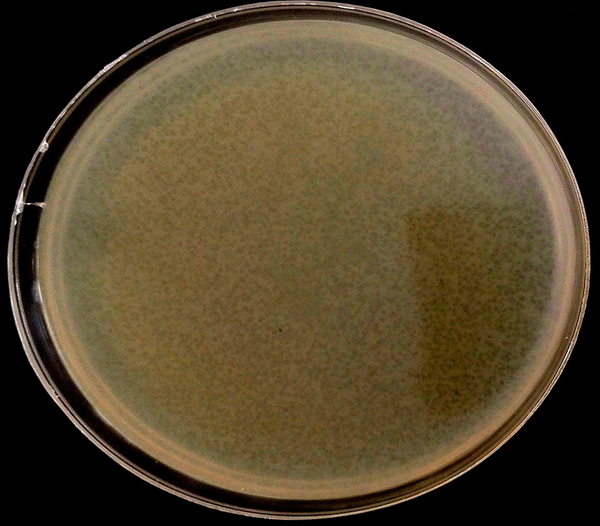
4-8. The result of electron microscopy showed that two phages were isolated. Group (I) had an icosahedral head and a long, noncontractile tail (400 nm; Figure 5). Group (II) had a distinct prolate head and a long, noncontractile tail (300 nm; Figure 6). Phages in Group (I) belonged to the family Siphoviridae (order Caudovirales), serogroup F, while phages in Group (II) belonged to the family Siphoviridae (order Caudovirales), serogroup A.
Electron Micrographs of the Family Siphoviridae Phage Serogroup F Negatively Stained With 2% Uranyl Acetate (pH = 4 - 4.5). Voltage 150 kV, Scale Bar = 60 nm
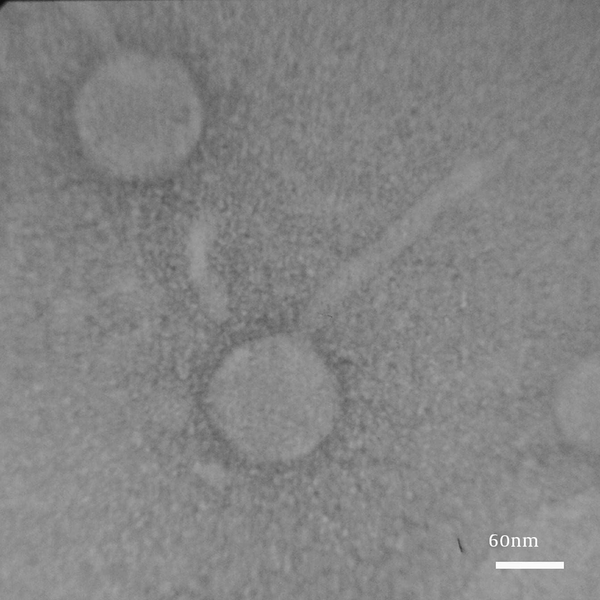
Electron Micrographs of the Family Siphoviridae Phage Serogroup A Negatively Stained With 2% Uranyl Acetate (pH = 4 - 4.5). Voltage 150 kV, Scale = 60 nm
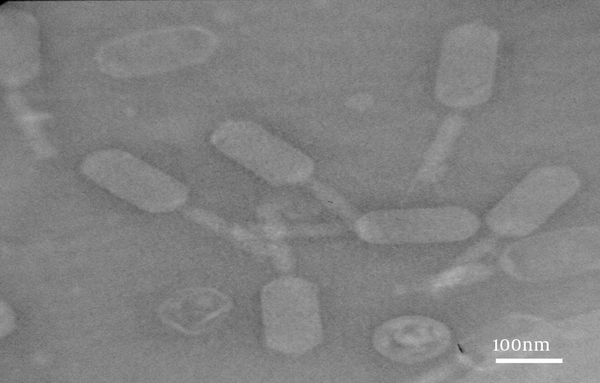
4-9. The single-step growth curve showed that the latent period of isolated bacteriophages was 70 minutes and the burst size was 2,400 PFU/infected host (Figure 7).
Single-Step Growth Curve
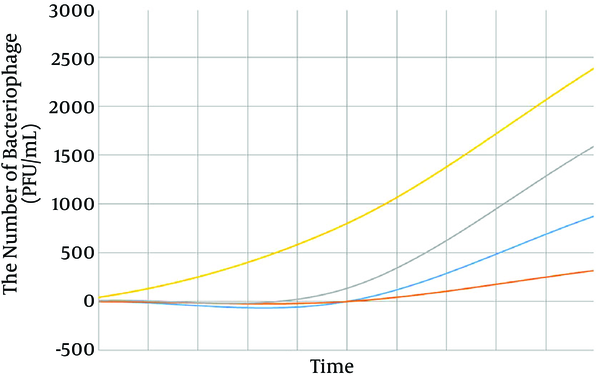
5. Discussion
In the current study, two phages against MRSA belonging to the family Siphoviridae were isolated from liquid sewage samples from a tertiary pediatric hospital. In previous studies, phages against MRSA have been isolated from different sources, such as cow’s milk, sewage/pond water, soil samples collected from poultry, and fecal samples from livestock farms; however, such phages have not been isolated from hospital wastewater (14, 16, 17, 34-36).
Isolation of phages is based on different sources; for example, in a study by Wommack et al. (2000) (37), phages were isolated from water samples from the TFF filtration apparatus used for the concentration of viruses from water samples. In a study by Dane et al. (2002) (38), phages from soil samples were extracted by centrifuging, sonication, and filtering the supernatant.
Phage isolation may not be an accessible or feasible method in the reference laboratory because such testing is sensitive and many variables can affect the results; for example, in our study, sewage samples were taken from different locations in the hospital, such as the aeration basin and vacuum pond, and those phages were not isolated. On the other hand, phages were isolated from sewage samples taken from the septic tank, and this process took a lot of time.
In Synnott et al.’s (2009) (9) study, phages against MRSA were isolated in liquefied sewage samples. Moreover, in a study by Chang et al. (2015) (35), phages against MRSA from skin were isolated; the results of electron microscopy showed that isolated phages belonged to the family Siphoviridae, serogroup B, and had a latent period time of 20 minutes. In a study by Kwiatek et al. (2011) (17), virulent bacteriophages (MSA6) were isolated from a cow with mastitis. The electron microscopy result of showed that the isolated phages belonged the family Myoviridae; they had a short latent period (15 minutes) and a relatively small burst size (23 PFU/cell). The isolated phages were capable infecting a wide spectrum of staphylococcal strains of both human and bovine origin. Moreover, Gupta et al. (2010) (14) used sewage/pond water samples and isolated three lytic phages (P-15/HP, P-27/HP and P-40/HP) against S. aureus host strains; phage P-27/HP showed a broad host spectrum that lysed to 17 S. aureus and coagulase-negative staphylococcus (CNS) isolates. In our study, phages isolated from hospital sewage belonged to the family Siphoviridae, serogroups A and F, with a latent period of 70 minutes; these phages exhibited lytic activity against coagulase-positive staphylococci.
In the current study, the lytic activity of phages was demonstrated through a spot test, and through DLA assay, the titer of phages was determined to be 3 × 109 PFU/mL, with formed plaques of 9 - 14 μm in diameter. In contrast, in research by Li et al. (2014) and Chhibber et al. (2013) (39, 40), phages were isolated from sewage samples and classified as members of the Myoviridae family; these produced clear plaques of a size of 2 - 3 mm in diameter with the titer of phages of more than 109 PFU/mL.
Antibiotic resistance, virulence factors, and toxins in bacteria strains are encoded by mobile genetic elements, such as prophages. These elements can be horizontally transferred by transduction. The presence of phages in hospital sewage may be one of the reasons for antibiotic resistance or virulence factors, as transduction may result in a nonvirulent strain of staphylococcus turning into a virulent one (41). Other research is still necessary for the full molecular characterization of bacteriophages, but some topics had to be neglected in the present research due to a lack of financial support (16-23). For instance, this study did not deal with the relation between antibiotic resistance in MRSA and the presence of phages, and this must be left for future work.
In this study, phages against MRSA belonging to the family Siphoviridae (order Caudovirales), serogroups A and F, were isolated from liquid sewage samples from a tertiary pediatric hospital. The presence of these phages may be one reason for transfer of antibiotic resistance or virulence factors through transduction in MRSA. Air-born phages can be transferred to the wards; thus, creating negative pressure in the sewage pipe at hospitals can prevent phages from entering wards via aerosols.
References
-
1.
Jevons MP, Coe AW, Parker MT. Methicillin resistance in staphylococci. Lancet. 1963;1(7287):904-7. [PubMed ID: 13957735].
-
2.
Berglund C, Soderquist B. The origin of a methicillin-resistant Staphylococcus aureus isolate at a neonatal ward in Sweden-possible horizontal transfer of a staphylococcal cassette chromosome mec between methicillin-resistant Staphylococcus haemolyticus and Staphylococcus aureus. Clin Microbiol Infect. 2008;14(11):1048-56. [PubMed ID: 19040477]. https://doi.org/10.1111/j.1469-0691.2008.02090.x.
-
3.
Rezai MS, Shahmohammadi S. Nosocomial Infections in Iranian Pediatric Patients With Burn Injuries: A Review. J Pediatr Rev. 2015;3(2):680. https://doi.org/10.17795/jpr-680.
-
4.
Diekema DJ, BootsMiller BJ, Vaughn TE, Woolson RF, Yankey JW, Ernst EJ, et al. Antimicrobial resistance trends and outbreak frequency in United States hospitals. Clin Infect Dis. 2004;38(1):78-85. [PubMed ID: 14679451]. https://doi.org/10.1086/380457.
-
5.
Pinto AN, Seth R, Zhou F, Tallon J, Dempsey K, Tracy M, et al. Emergence and control of an outbreak of infections due to Panton-Valentine leukocidin positive, ST22 methicillin-resistant Staphylococcus aureus in a neonatal intensive care unit. Clin Microbiol Infect. 2013;19(7):620-7. [PubMed ID: 22900572]. https://doi.org/10.1111/j.1469-0691.2012.03987.x.
-
6.
Navidinia M. Detection of inducible clindamycin resistance (MLSBi) among methicillin-resistant Staphylococcus aureus (MRSA) isolated from health care providers. J Paramedical Sci. 2015;6(1):91-6.
-
7.
Behzadnia S, Davoudi A, Rezai MS, Ahangarkani F. Nosocomial infections in pediatric population and antibiotic resistance of the causative organisms in north of iran. Iran Red Crescent Med J. 2014;16(2):14562. [PubMed ID: 24719744]. https://doi.org/10.5812/ircmj.14562.
-
8.
Ghasemian A, Mirzaee M. Methicillin Resistant Staphylococcus aureus (MRSA) Strains and the Staphylococcal Cassette Chromosome mec Types in Iran. Infect Epidemiol Med. 2016;2(3):31-4.
-
9.
Synnott AJ, Kuang Y, Kurimoto M, Yamamichi K, Iwano H, Tanji Y. Isolation from sewage influent and characterization of novel Staphylococcus aureus bacteriophages with wide host ranges and potent lytic capabilities. Appl Environ Microbiol. 2009;75(13):4483-90. [PubMed ID: 19411410]. https://doi.org/10.1128/AEM.02641-08.
-
10.
Navidinia M, Fallah F, Lajevardi B, Shirdoost M, Jamali J. Epidemiology of Methicillin-Resistant Staphylococcus aureus Isolated From Health Care Providers in Mofid Children Hospital. Arch Pediatr Infect Dis. 2015;3(2):16458. https://doi.org/10.5812/pedinfect.16458.
-
11.
Pirnay JP, De Vos D, Verbeken G, Merabishvili M, Chanishvili N, Vaneechoutte M, et al. The phage therapy paradigm: pret-a-porter or sur-mesure? Pharm Res. 2011;28(4):934-7. [PubMed ID: 21063753]. https://doi.org/10.1007/s11095-010-0313-5.
-
12.
Fischetti VA. Bacteriophage endolysins: a novel anti-infective to control Gram-positive pathogens. Int J Med Microbiol. 2010;300(6):357-62. [PubMed ID: 20452280]. https://doi.org/10.1016/j.ijmm.2010.04.002.
-
13.
Sulakvelidze A, Alavidze Z, Morris JG. Bacteriophage therapy. Antimicrob Agents Chemother. 2001;45(3):649-59. [PubMed ID: 11181338]. https://doi.org/10.1128/AAC.45.3.649-659.2001.
-
14.
Gupta R, Prasad Y. Efficacy of polyvalent bacteriophage P-27/HP to control multidrug resistant Staphylococcus aureus associated with human infections. Curr Microbiol. 2011;62(1):255-60. [PubMed ID: 20607539]. https://doi.org/10.1007/s00284-010-9699-x.
-
15.
Matsuzaki S, Rashel M, Uchiyama J, Sakurai S, Ujihara T, Kuroda M, et al. Bacteriophage therapy: a revitalized therapy against bacterial infectious diseases. J Infect Chemother. 2005;11(5):211-9. [PubMed ID: 16258815]. https://doi.org/10.1007/s10156-005-0408-9.
-
16.
Kraushaar B, Thanh MD, Hammerl JA, Reetz J, Fetsch A, Hertwig S. Isolation and characterization of phages with lytic activity against methicillin-resistant Staphylococcus aureus strains belonging to clonal complex 398. Arch Virol. 2013;158(11):2341-50. [PubMed ID: 23760627]. https://doi.org/10.1007/s00705-013-1707-6.
-
17.
Kwiatek M, Parasion S, Mizak L, Gryko R, Bartoszcze M, Kocik J. Characterization of a bacteriophage, isolated from a cow with mastitis, that is lytic against Staphylococcus aureus strains. Arch Virol. 2012;157(2):225-34. [PubMed ID: 22045271]. https://doi.org/10.1007/s00705-011-1160-3.
-
18.
Brussow H, Canchaya C, Hardt WD. Phages and the evolution of bacterial pathogens: from genomic rearrangements to lysogenic conversion. Microbiol Mol Biol Rev. 2004;68(3):560-602. [PubMed ID: 15353570]. https://doi.org/10.1128/MMBR.68.3.560-602.2004.
-
19.
Bin S, Xiong HY, Yan X, Zhang L. Isolation of a novel polyvalent virulent bacteriophage of E. coli. J Med Colleges PLA. 2007;22(5):261-7. https://doi.org/10.1016/S1000-1948(07)60054-9.
-
20.
Li X, Ding P, Han C, Fan H, Wang Y, Mi Z, et al. Genome analysis of Enterococcus faecalis bacteriophage IME-EF3 harboring a putative metallo-beta-lactamase gene. Virus Genes. 2014;49(1):145-51. [PubMed ID: 24818695]. https://doi.org/10.1007/s11262-014-1079-3.
-
21.
Chen CR, Lin CH, Lin JW, Chang CI, Tseng YH, Weng SF. Characterization of a novel T4-type Stenotrophomonas maltophilia virulent phage Smp14. Arch Microbiol. 2007;188(2):191-7. [PubMed ID: 17440710]. https://doi.org/10.1007/s00203-007-0238-5.
-
22.
Shen GH, Wang JL, Wen FS, Chang KM, Kuo CF, Lin CH, et al. Isolation and characterization of phikm18p, a novel lytic phage with therapeutic potential against extensively drug resistant Acinetobacter baumannii. PLoS One. 2012;7(10):46537. [PubMed ID: 23071586]. https://doi.org/10.1371/journal.pone.0046537.
-
23.
Mattila S, Ruotsalainen P, Jalasvuori M. On-Demand Isolation of Bacteriophages Against Drug-Resistant Bacteria for Personalized Phage Therapy. Front Microbiol. 2015;6:1271. [PubMed ID: 26617601]. https://doi.org/10.3389/fmicb.2015.01271.
-
24.
Yang CM, Lin MF, Liao PC, Yeh HW, Chang BV, Tang TK, et al. Comparison of antimicrobial resistance patterns between clinical and sewage isolates in a regional hospital in Taiwan. Lett Appl Microbiol. 2009;48(5):560-5. [PubMed ID: 19291216]. https://doi.org/10.1111/j.1472-765X.2009.02572.x.
-
25.
Colomer-Lluch M, Imamovic L, Jofre J, Muniesa M. Bacteriophages carrying antibiotic resistance genes in fecal waste from cattle, pigs, and poultry. Antimicrob Agents Chemother. 2011;55(10):4908-11. [PubMed ID: 21807968]. https://doi.org/10.1128/AAC.00535-11.
-
26.
Pathak S, Gaur A, Bhattacherjee J. Distribution and antibiotic resistance among aerobic heterotrophic bacteria from rivers in relation to pollution. J Environ Sci Health Part A. 1993;28(1):73-87. https://doi.org/10.1080/10934529309375863.
-
27.
Feiner R, Argov T, Rabinovich L, Sigal N, Borovok I, Herskovits AA. A new perspective on lysogeny: prophages as active regulatory switches of bacteria. Nat Rev Microbiol. 2015;13(10):641-50. [PubMed ID: 26373372]. https://doi.org/10.1038/nrmicro3527.
-
28.
Feng Y, Chen CJ, Su LH, Hu S, Yu J, Chiu CH. Evolution and pathogenesis of Staphylococcus aureus: lessons learned from genotyping and comparative genomics. FEMS Microbiol Rev. 2008;32(1):23-37. [PubMed ID: 17983441]. https://doi.org/10.1111/j.1574-6976.2007.00086.x.
-
29.
Rahimzadeh G, Gill P, Rezai MS. Characterization and lytic activity of methicillin-resistant Staphylococcus aureus (MRSA) phages isolated from NICU. Australasian Med J. 2016;9(6):169-75.
-
30.
Martha RJC, Andrew MK. Bacteriophages Methods and Protocols. New York: USA. 2009.
-
31.
Brown DF, Edwards DI, Hawkey PM, Morrison D, Ridgway GL, Towner KJ, et al. Guidelines for the laboratory diagnosis and susceptibility testing of methicillin-resistant Staphylococcus aureus (MRSA). J Antimicrob Chemother. 2005;56(6):1000-18. [PubMed ID: 16293678]. https://doi.org/10.1093/jac/dki372.
-
32.
Rezaei M, Chavoshzadeh Z, Haroni N, Armin S, Navidinia M, Mansouri M. Colonization with Methicillin Resistant and Methicillin Sensitive Staphylococcus aureus Subtypes in Patients with Atopic Dermatitis and Its Relationship with Severity of Eczema. Arch Pediatr Infec Dis. 2013;1(2):53-6. https://doi.org/10.5812/pedinfect.8969.
-
33.
Rezai MS, Pourmousa R, Dadashzadeh R, Ahangarkani F. Multidrug resistance pattern of bacterial agents isolated from patient with chronic sinusitis. Caspian J Intern Med. 2016;7(2):114-9. [PubMed ID: 27386063].
-
34.
Kahankova J, Pantucek R, Goerke C, Ruzickova V, Holochova P, Doskar J. Multilocus PCR typing strategy for differentiation of Staphylococcus aureus siphoviruses reflecting their modular genome structure. Environ Microbiol. 2010;12(9):2527-38. [PubMed ID: 20406289]. https://doi.org/10.1111/j.1462-2920.2010.02226.x.
-
35.
Chang Y, Shin H, Lee JH, Park CJ, Paik SY, Ryu S. Isolation and Genome Characterization of the Virulent Staphylococcus aureus Bacteriophage SA97. Viruses. 2015;7(10):5225-42. [PubMed ID: 26437428]. https://doi.org/10.3390/v7102870.
-
36.
Deghorain M, Van Melderen L. The Staphylococci phages family: an overview. Viruses. 2012;4(12):3316-35. [PubMed ID: 23342361].
-
37.
Wommack KE, Colwell RR. Virioplankton: viruses in aquatic ecosystems. Microbiol Mol Biol Rev. 2000;64(1):69-114. [PubMed ID: 10704475].
-
38.
Dane J, Grossman R, Reinsch T, Topp G. Methods of soil analysis. America: Soil Science Society of America; 2002.
-
39.
Chhibber S, Kaur T, Sandeep K. Co-therapy using lytic bacteriophage and linezolid: effective treatment in eliminating methicillin resistant Staphylococcus aureus (MRSA) from diabetic foot infections. PLoS One. 2013;8(2):56022. [PubMed ID: 23418497]. https://doi.org/10.1371/journal.pone.0056022.
-
40.
Li L, Zhang Z. Isolation and characterization of a virulent bacteriophage SPW specific for Staphylococcus aureus isolated from bovine mastitis of lactating dairy cattle. Mol Biol Rep. 2014;41(9):5829-38. [PubMed ID: 24981924]. https://doi.org/10.1007/s11033-014-3457-2.
-
41.
Cohen S, Sweeney HM. Transduction of Methicillin Resistance in Staphylococcus aureus Dependent on an Unusual Specificity of the Recipient Strain. J Bacteriol. 1970;104(3):1158-67. [PubMed ID: 16559089].